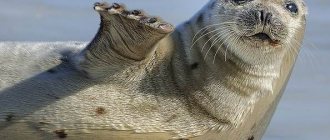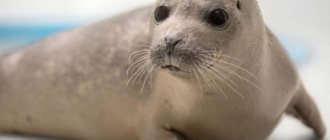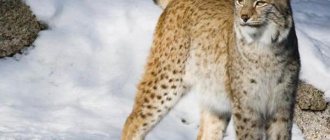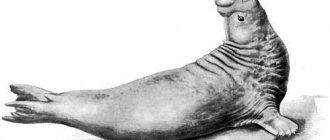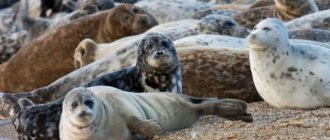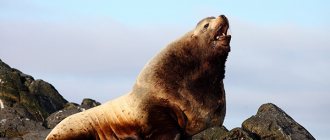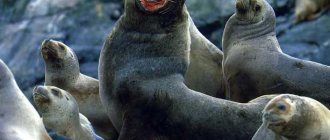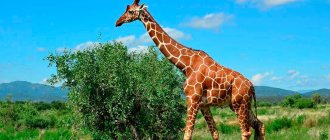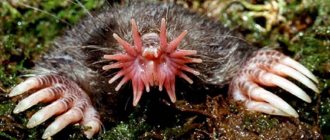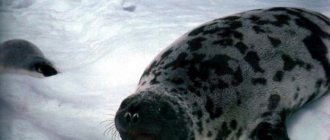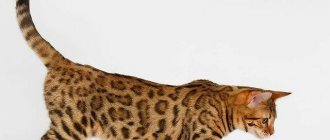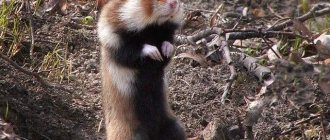Harp seal pups are one of the cutest representatives of the animal kingdom: a large head and huge eyes (like human babies) plus snow-white fur covering the entire body. The Pomors, who have long been fishing in the White Sea, gave their names to the adults and pups of the harp seal, which are still used today. An adult male is called a coot, an adult female is called a utelga, but the seal pups, depending on their age, can be called greens, whites, khokhlushas and serks. In the scientific literature, all seal pups are usually called pups. This is due to the fact that in the scientific classification, harp seals belong to the suborder Canidae. Pregnancy in harp seals lasts longer than in humans - 11.5 months, although this period also includes 4.5 months when the fertilized egg is in “hibernation” and does not develop. In summer, seals live far in the North - at the edge of the ice of the Barents and Kara Seas, near Spitsbergen, Novaya Zemlya, Franz Josef Land and Severnaya Zemlya. In late autumn they begin to move south, and in January–February they appear in the White Sea. To breed, seals choose strong ice floes, arranging so-called “nursery haulouts” on them, sometimes stretching for tens of kilometers and numbering tens of thousands of individuals. Ice has excellent antiseptic properties, because... low temperatures prevent bacteria from developing. Females give birth to their seal pups from late January to late April, with most pups born between 20 February and 5 March. A newborn reaches a length of 80-92 cm and a weight of 8-10 kg. After birth, a seal pup is covered with thick and long hair, white, with a greenish tint, which is the result of exposure to amniotic fluid in the mother's womb.
Description of animals
The weight and length of the animal can vary greatly - from ninety-five kilograms to three tons, from one and a half to six meters. The smallest species is the ringed seal, the largest is the elephant seal. Typically the color of the animal is brown, gray or reddish. Under natural conditions, females live up to thirty-five years, and males - up to twenty. The body of the animal is spindle-shaped, the head is small, tapering in front. A short and inactive neck, no ears. Well defined but short tail. The front flippers are quite short (less than twenty-five percent of the total body length). They are much shorter than the rear ones.
Kinds
Seals are the families of true and eared seals, and in a broad sense, all pinnipeds. These include 24 species, which vary, but retain many common features. Pacific seal colonies are slightly larger than Atlantic populations. But great similarities unite representatives of all regions. Some species are the most famous.
Monk seal. Prefers the waters of the Mediterranean Sea as opposed to its Arctic relatives. Adult individuals weigh on average 250 kg, body length is 2-3 m. Due to the light color of the belly, it is called white-bellied. Previously, the habitat covered the Black Sea, the seal was found in our country, but the population has decreased. On the coast of the warm sea there are no more places for animal rookeries - everything is built up by man. The monk is listed in the Red Book. The Caribbean monk seal's sister species is already considered extinct.
Monk Seal
Crabeater seal. The mammal received its name for its food addiction. The seal is distinguished by a narrow muzzle, medium body sizes: length on average 2.5 m, weight 250-300 kg. Crabeaters live in Antarctica and the southern seas. They often set up rookeries on floating ice floes. The most numerous species.
Crabeater seal
Common seal. It is found in different places of the northern Arctic hemisphere: in Russia, Scandinavia, North America. They live in coastal waters and do not migrate. Weight on average 160-180 kg, length 180 cm. Reddish-gray color dominates among other shades. Poaching has led to the threat of extinction of the species.
harbor seal
Harp seal. Relatively small in size - 170-180 cm in length, weight approximately 130 kg. Males are distinguished by a special color - silvery fur, black head, dark sickle-shaped stripe from the shoulders.
harp seal
Striped seal. A unique representative of mammals, a “zebra” among glaciers. On a dark background, close to black, there are ring-shaped stripes up to 15 cm wide. Only males are distinguished by a bright outfit. The stripes of females are practically invisible. The second name for seals is lionfish. Northern seals are found in the Tatar Strait, Bering, Chukchi, and Okhotsk seas.
Striped seal
Sea leopard. The spotted skin and aggressive behavior gave the predator its name. The vicious relative attacks smaller seals, but the leopard seal's favorite delicacy is penguins. The predator reaches a length of 4 m, the weight of an adult leopard seal is up to 600 kg. Found on the coast of Antarctica.
Leopard seal
Sea Elephant. The name emphasizes the gigantic size of the animal, length 6.5 m, weight 2.5 tons, trunk-shaped nose in males. The northern subspecies lives off the coast of North America, the southern subspecies lives in Antarctica.
Sea Elephant
Sea hare (sealed seal). In winter, the maximum weight of a well-fed animal reaches 360 kg. The massive body is 2.5 m long. Powerful jaws with small teeth. The heavy animal stays on land near holes, on the edge of thawed patches. They live alone. The character is peaceful.
bearded seal
Reproduction and feeding
During the mating season, seals stay in pairs. The birth of the calf usually occurs on the ice. One puppy is born. He is born sighted and fully physically formed. Most often, females try to hide their cubs in snow holes. Feeding with milk stops when the cub is not yet able to obtain food for itself, so from two to twelve weeks the animals starve, surviving only on accumulated fat.
Where does this beast live?
The habitat of this representative of the fauna is quite extensive; it is widespread in Arctic waters. The harp seal is found in the Arctic Ocean, in the White Sea, on the coast of the Labrador Peninsula and the island of Newfoundland. A representative of this species can be found north of Jan Mayen Island. Outside the mating season, animals also occupy other territorial spaces, for example, in the Barents and Kara seas. This species can also be found even in the Atlantic corners of Canada and the island of Greenland.
Baby seal: what is it called?
These are perhaps the most charming representatives of the animal world - a large head and large, wide-open eyes. In addition, these babies have snow-white fur covering their entire body. Since ancient times, the Pomors called an adult male seal bald, a female seal - utelga, and their cubs were called differently, depending on age - whites, greens, serks, khokhlushkas. All these names are correct and relevant today. In scientific literature, a small seal is most often called a pup. And such a baby is also called a baby seal.
Seal Pup: Birth
During the summer months, seals live in the Far North. In late autumn they begin to move south. For breeding, they choose large and durable ice floes, on which “nursery breeding grounds” are created, which can stretch for tens of kilometers. The number of animals in such “colonies” numbers tens of thousands of individuals. Seal pregnancy lasts eleven and a half months. It must be said that ice is a reliable antiseptic: very low temperatures do not allow microbes to develop. The birth of babies occurs from January to April. The bulk of the cubs appear from the twentieth of February to the fifth of March.
Interesting Facts
First, twins are born very rarely; usually, one baby is born at a time. Its dimensions are as follows: length - 1 meter, weight - approximately 8 kilograms. After birth, a baby harp seal gains about 2 kilograms per day. Basic nutrients are transmitted through mother's milk, which is very fatty, which in fact contributes to rapid weight gain.
Another interesting fact is related to the molting of the coot. The molting of this harmless animal is a rather long and painful process, which occurs at the end of March. In addition to the hair, the skin itself is renewed. During molting, the animal loses a lot of weight because it practically does not eat. Upon completion of this action and with the resumption of an active lifestyle, the weight is quickly restored.
White seal
The greenish tint does not last long. By the way, it is formed under the influence of amniotic fluid in the womb. After five days, it disappears completely, and the baby seal, the photo of which you see in this article, turns into the most charming creature of absolutely white color. At this time he is very dependent on his mother. A female seal feeds her pup every four to five hours. Her milk is very fatty (up to fifty percent fat). Thanks to this, the baby gains up to three kilograms of weight every day. During this period, the seal pup is very defenseless. What is it called at this time? Of course, Belek.
Features of a baby seal
The squirrel's huge eyes are constantly watering, so it seems that the animal is crying. But this is a natural process for moisturizing the eyes. Belek, the baby seal, is constantly trembling. This is explained by the regulation of heat in his body. He has not yet formed a fat layer, like an adult animal. The squirrel's fur consists of transparent hollow hairs that allow sunlight to pass through the black skin, thereby warming it.
Habitat
Seals are distributed very widely; in total, the ranges of different species cover the entire globe. Seals reach their greatest diversity in the cold latitudes of the Arctic and Antarctic, but the monk seal, for example, lives in the Mediterranean. All types of seals are closely associated with water and live either on the coasts of seas and oceans, or on vast expanses of pack (perennial) ice.
Several species of seals (Baikal and Caspian seals) live isolated in the internal lakes of continents (Baikal Island and the Caspian Sea, respectively). Real seals migrate short distances; they are not characterized by long migrations like fur seals, for example.
Existing misconceptions
For a long time, researchers of these animals believed that the female, who needs to leave from time to time in search of food for herself, finds the squirrel by its voice. This is wrong. A seal pup has a unique scent that helps its mother find it.
It was believed that a baby seal (whose name is Belek), which was once stroked by a person, would forever remain an “orphan.” The female will no longer approach him. This is not true. If you happen to visit the North Pole, you can pet these charming animals as much as you like, but you must do this with gloves, as they react very negatively to a human hand that is too “hot” for them.
And one more piece of advice. When petting the baby and playing with it, do not block it from the mother - having lost sight of the baby, she may rush to attack.
It is important to know!
The harp seal is an amazing, harmless animal that hunts only fish found in its habitat. The inhabitants of the Arctic cold waters have practically no enemies; the main mammals that pose a danger are polar bears and killer whales. But for the former, it is quite difficult to catch a seal on ice floes due to its maneuverability. Killer whales rarely pose a danger to these animals due to their habitat. Usually, when killer whales arrive in the waters, the seals have already migrated to a safer place.
The main danger for such animals is humans - this is unconditional and undeniable. Humans cause damage to the harp seal population both directly and indirectly. Such animals are exterminated directly for their valuable fat. But this fishery is limited by quotas to preserve the population. Excessive fishing is much worse. After all, it is the main diet for coots, by the way, and not only for them.
Now you know who the harp seal is, what it eats and where it lives. In addition, we told you some interesting facts.
Animal protection
The very first organization to defend the whites was the International Foundation IFAW. It is to protect these charming animals with valuable fur that this organization was created. The foundation extends its work to Canada and Russia. Many famous people of the planet also joined his work. Brigitte Bardot organized a demonstration at the Norwegian embassy in 1977. Then the President of France banned the import of squirrel fur products into the country. Therefore, it is rightly believed that France is the first country to introduce special prohibitory measures aimed at protecting these animals. Paul McCartney later joined the defense. He flew to Canada to slaughter sites and held several charity events.
